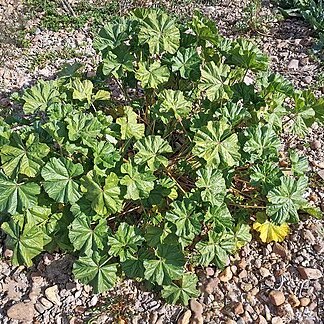Herbs, sometimes more or less suffruticose, annual or perennial, the stems erect to decumbent or prostrate, glabrous or the indumentum of simple or stellate hairs. Leaves usually long-petiolate, the stipules caducous, the blades commonly more or less circular-cordate in outline, crenate to serrate or shallowly to deeply palmati-lobed or palmatidivided. Flowers axillary, solitary or in more or less dense glom-erules; epicalyx of 3 distinct bractlets; calyx cupuliform, 5-lobed, persistent or accrescent; petals 5, obcordate-cuneate, connate at the base and adnate to the base of the staminal tube, the claws glabrous or ciliate; staminal tube divided at the apex into numerous filaments, the anthers reniform; ovary of more or less 10 free, 1-ovulate carpels, the ovules ascending; style branches isomerous with the carpels, linear, introrsely stigmatose. Fruits discoid, separating into many indehiscent meri-carps, these verticillate around a central axis, reniform, muticous; seeds glabrous; embryo curved, the albumen scant.
Herbs annual or perennial, ascending or erect. Leaves alternate; stipule sessile, usually ciliate, persistent; leaf blade palmately lobed or sometimes deeply dissected. Flowers solitary or fascicled, axillary. Involucellar bracts usually 3, linear or foliaceous, usually free. Calyx cup-shaped, 5-lobed, often accrescent and spreading in fruit. Petals 5, usually purple, sometimes white, rose to dark red, apex usually emarginate or with a prominent notch. Anthers borne on staminal column apex. Ovary with 9-15 pistils; ovule 1 per locule, erect; style branches as many as pistils, adaxial surface stigmatic. Fruit a schizocarp, oblate, pubescent or glabrous; mericarps 9-15, indehiscent, mature carpels without spines. Seeds 1 per mericarp.
Annual or perennial herbs. Lvs toothed, lobed or deeply dissected. Fls usually solitary and axillary or in axillary clusters, rarely in terminal racemes; epicalyx segments (2)-3, free ± to base; calyx evenly 5-toothed; petals spreading, emarginate or deeply notched. Style branches as many as loculi, filiform. Fr. of numerous 1-seeded, indehiscent, awnless mericarps arranged in a single flat whorl round short conic apex of receptacle.
Bractlets of the epicalyx 3, linear to obovate; stamen-column bearing anthers at the summit; pet truncate to (in our spp.) obcordate; carpels 10–20, beakless, one-seeded, indehiscent, the sides incompletely covering the seed; styles slender, stigmatic along the inner side; annual to perennial herbs with broad, toothed to lobed or parted lvs, the fls solitary or fascicled in the axils. 25, temp. Eurasia.
Ovary of 9–15 free 1-ovulate carpels arranged around a central torus; style-branches as many as there are carpels, obliquely clavate; stigmas linear, decurrent on the inside of the style-branches.
Fruit discoid, separating at maturity into suborbicular-reniform free indehiscent muticous mericarps; mericarps smooth or variously sculptured on the back, glabrous or pubescent.
Annuals or perennials, herbaceous to somewhat suffruticose, erect to decumbent or prostrate, nearly glabrous to more or less densely pubescent.
Petals usually obcordate-cuneate, emarginate at the apex, often with darker-coloured veins converging towards the glabrous or ciliate claw.
Leaves usually suborbicular-reniform in outline, crenate to serrate or shallowly to rather deeply palmatilobed, usually long-petioled.
Flowers axillary, usually clustered or fasciculate; pedicels often short to 0.
Epicalyx of 3 free or nearly free linear to ovate bracts.
Staminal tube antheriferous at the apex only.
Calyx cupular, 5-lobed; lobes deltoid, acute.

